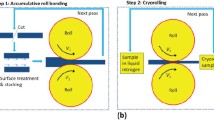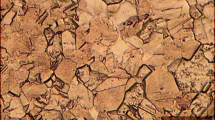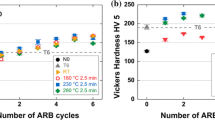Abstract
Tensile tests and strain-rate jump tests were carried out at several temperatures below room temperature on Cu processed by accumulative roll-bonding (ARB). The temperature dependences of the flow stress and the activation volume were determined. In contrast to conventional coarse-grained materials where the activation volume increases with increasing temperature, the ARB processed copper by 8 cycles with ultrafine-grains showed inverse temperature dependence of activation volume, i.e., decreased activation volume with increasing temperature. This inverse temperature dependence of the activation volume is discussed in terms of thermally activated dislocation bow-out from grain-boundaries.





Similar content being viewed by others
References
Meyers MA, Mishra A, Benson DJ (2006) Prog Mater Sci 51:427–556
Azushima A, Kopp R, Korhonen A, Yang DY, Micari F, Lahoti GD, Groche P, Yanagimoto J, Tsuji N, Rosochowski A, Yanagida A (2008) CIRP Ann-Manuf Technol 57:716–735
Valiev RZ (2007) J Mater Sci 42:1483–1490. doi:10.1007/s10853-006-1281-3
Zhilyaev AP, McNelley TR, Langdon TG (2007) J Mater Sci 42:1517–1528. doi:10.1007/s10853-006-0628-0
Langdon TG (2007) J Mater Sci 42:3388–3397. doi:10.1007/s10853-006-1475-8
Mishra A, Richard V, Gregori F, Asaro RJ, Meyers MA (2005) Mater Sci Eng A 410–411:290–298
Takata N, Yamada K, Ikeda K, Yoshida F, Nakashima H, Tsuji N (2007) Mater Trans 48:2043–2048
Edalati K, Fujioka T, Horita Z (2008) Mater Sci Eng A 497:168–173
Ito Y, Horita Z (2009) Mater Sci Eng A 503:32–36
Hanazaki K, Shigeiri N, Tsuji N (2010) Mater Sci Eng A 527:5699–5707
Kunimine T, Takata N, Tsuji N, Fujii T, Kato M, Onaka S (2009) Mater Trans 50:64–69
Huang X, Hansen N, Tsuji N (2006) Science 312:249–251
Wang YM, Hamza AV, Ma E (2006) Acta Mater 54:2715–2726
Wang YM, Cheng S, Wei QM, Ma E, Nieh TG, Hamza A (2004) Scr Mater 51:1023–1028
Conrad H (1965) In: Zackay VF (ed) High-Strength Materials. John Wiley & Sons, Inc, New York
Bochniak W (1995) Acta Metall Mater 43:225–233
Conrad H, Yang D (2002) J Electron Mater 31:304–312
Conrad H (2003) Mater Sci Eng A 341:216–228
Cheng S, Spencer JA, Milligan WW (2003) Acta Mater 51:4505–4518
Kato M, Fujii T, Onaka S (2008) Mater Trans 49:1278–1283
Kato M (2009) Mater Sci Eng A 516:276–282
Tsuji N, Saito Y, Utsunomiya H, Tanigawa S (1999) Scr Mater 40:795–800
Tsuji N (2006) In: Altan BS, Miskioglu I, Purcek G, Mulyukov RR, Artan R (eds) Severe plastic deformation: towards bulk production of nanostructured materials. NOVA Science Publishers, New York
Kunimine T, Fujii T, Onaka S, Tsuji N, Kato M, in press
Shen YF, Lu L, Dao M, Suresh S (2006) Scr Mater 55:319–322
Dalla Torre FH, Pereloma EV, Davies CHJ (2006) Acta Mater 54:1135–1146
Estrin Y, Kim HS, Nabarro FRN (2007) Acta Mater 55:6401–6407
Frost HJ, Ashby MF (1982) Deformation-Mechanism Maps. Pergamon, Oxford
Acknowledgements
This research was supported by a Grant-in-Aid for Scientific Research on Innovative Areas “Bulk Nanostructured Metals” (22102006) from the Ministry of Education, Culture, Sports, Science and Technology (MEXT) of Japan. T. Kunimine is grateful for the support of the Global COE Program (Education and Research Center for Material Innovation) in Tokyo Institute of Technology, MEXT, Japan.
Author information
Authors and Affiliations
Corresponding author
Appendix. Derivation of Eq. 3 from Eq. 2
Appendix. Derivation of Eq. 3 from Eq. 2
Eq. 2 can be rewritten as
where \( \eta = L_{\text{GB}} /(2r) > 0 \) and \( \delta \eta = w^{\ast} /(2r) > 0 \). The authors also have \( \eta = L_{\text{GB}} /(2r) = \sin \theta \) where θ is the critical bow-out angle. Since the activation distance w* of the pinning point is naturally much shorter than the average distance \( L_{\text{GB}} \) between pinning points, the authors have \( \left| {\delta \eta /\eta } \right| \ll 1 \).
The function \( \sin^{ - 1} \left( \eta \right) \) in the right side of Eq. 11 is given by the series written as
where \( \left( {2n - 1} \right)!! = \left( {2n - 1} \right)\left( {2n - 3} \right) \ldots \, 3 \cdot 1 \) and \( \left( {2n} \right)!! = \left( {2n} \right)\left( {2n - 2} \right) \ldots \, 4 \cdot 2. \) When \( \left| {\delta \eta /\eta } \right| \ll 1 \), we have
When θ is not so large, for example, θ < 1, the higher-order terms of \( \eta^{2n} \), such as \( \eta^{6} \), \( \eta^{8} \), \( \eta^{10} \),…, can be regarded much smaller than \( \eta^{0} = 1 \). Hence, we have
When \( 0 < \delta \eta /\eta \ll 1 \) is satisfied and the higher-order terms of \( \eta^{2n} \) are neglected, we also have
From Eqs. 11, 15 and 16, the authors have
Using \( \eta = L_{\text{GB}} /(2r) \), \( \delta \eta = w^{\ast} /(2r) \) and \( r = L_{\text{GB}} /(2\sin \theta ) \), Eq. 3 can be obtained from Eq. 17.
Rights and permissions
About this article
Cite this article
Kunimine, T., Aragaki, T., Fujii, T. et al. Inverse temperature dependence of activation volume in ultrafine-grained copper processed by accumulative roll-bonding. J Mater Sci 46, 4302–4307 (2011). https://doi.org/10.1007/s10853-010-5243-4
Received:
Accepted:
Published:
Issue Date:
DOI: https://doi.org/10.1007/s10853-010-5243-4




